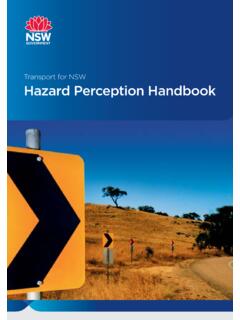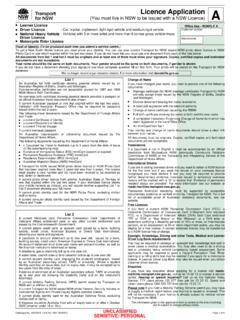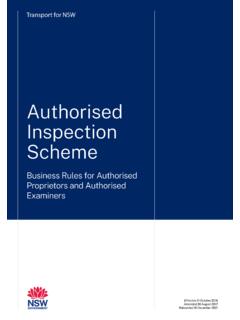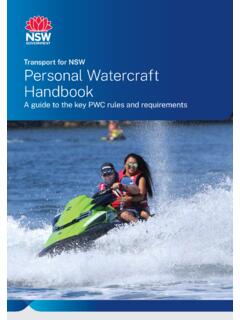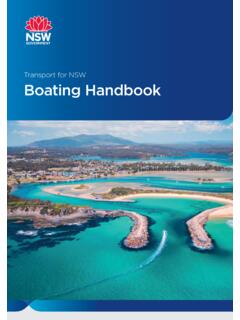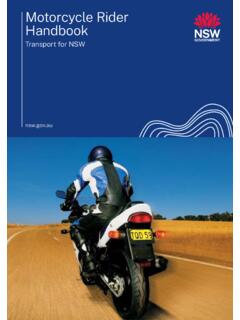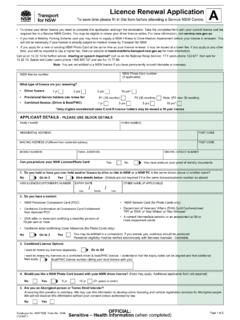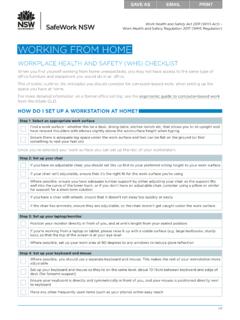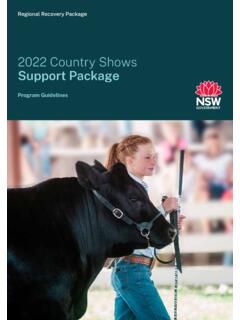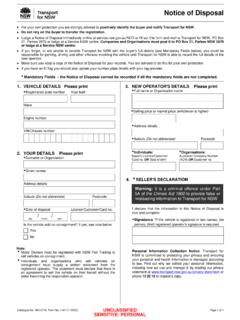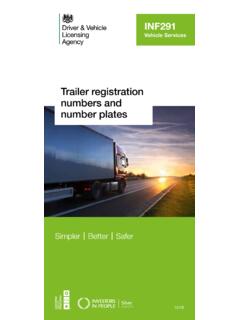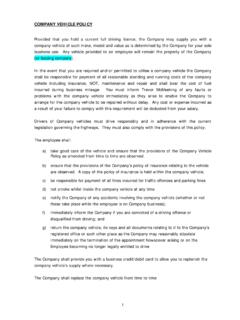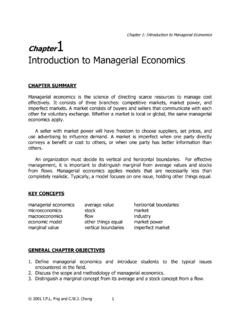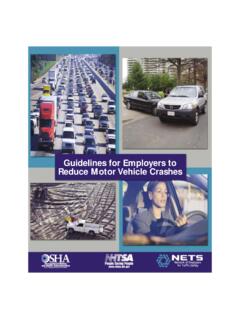Transcription of Vehicle Standards Information - NSW Government
1 Transport for NSW , Rev. 3 - supersedes Rev. , issued 1 November 2007 Page 1 of 18 Vehicle Standards Information | Rev. 3 | 8 November 2013 06 Light Vehicle modifications A guide to modifications requiring certification under the Vehicle Safety and Compliance Certification Scheme Purpose This Vehicle Standards Information (VSI) No. 6 is intended to help Vehicle owners and modifiers determine what modifications to vehicles up to and including tonnes gross Vehicle mass require certification. Introduction Vehicle owners sometimes modify their Vehicle to give it a distinctive appearance, improve its performance, add features, change the engine, change the suspension, add a long-range fuel tank, or for a combination of reasons. Others modify their vehicles so that they are better suited to a specialised purpose.
2 Vehicle owners who intend to modify their vehicles need to follow the Standards and guidelines that apply to the modification of vehicles for use on roads and/or road-related areas. This will ensure that each completed Vehicle is safe for use and that the level of safety afforded by a Vehicle to its passengers and other road users is not compromised by any modification/s. Certification of significant modifications When modifications to a Vehicle are significant, the Vehicle will require a compliance certificate issued by a person accredited as a licensed certifier on the TfNSW Vehicle Safety and Compliance Certification Scheme (VSCCS). To make it clear to Vehicle owners and modifiers when a modified Vehicle requires a compliance certificate, a new legal document has been developed.
3 The document, the Vehicle Safety Compliance Certification Scheme Declaration of Modification or Class of Modification Order 2013 (the Order) contains a list of modifications that require certification. This VSI No. 6 is intended to clarify technical content of the Order. It provides examples and tips when modifying a light Vehicle , and will assist you in determining whether your Vehicle requires certification. Following these guidelines will assist you in ensuring that your Vehicle meets all applicable New South Wales regulations and that its safety levels are maintained. This VSI No. 6 should be read in conjunction with the Order. , Rev. 3 - supersedes Rev. , issued 1 November 2007 Page 2 of 18 Compliance with Vehicle safety Standards Vehicle Standards legislation Vehicles registered in NSW must (unless exempted) meet Schedule 2 of the Road Transport ( Vehicle Registration) Regulation 2017, including compliance with the design Standards set out in the applicable Australian Design Rules (ADRs).
4 A Vehicle that is modified and certified according to the Order must continue to meet the applicable requirements as set out above. Australian design rules Any modification to a Vehicle (whether or not listed in the Order) has the potential to affect one or more ADRs. Unless exempted by TfNSW (or ADRs do not apply to that Vehicle ), any modification that affects an applicable ADR will require certification; for example, a pole- mounted Information technology (IT) screen is likely to affect one or more ADRs, and if this is the case, a VSCCS certificate will be required for the modification. Code of practice for light Vehicle modifications Vehicle Standards Bulletin ( ) National Code of Practice for Light Vehicle Construction and Modification outlines the minimum design, construction, installation and performance requirements for modifications to light vehicles, for building individually constructed vehicles (ICVs) and for the certification of certain imported vehicles.
5 Following the guidance provided in will help ensure that work undertaken will meet the Standards set down in NSW regulations. Most of the modifications listed in the Order have corresponding practical guidance in is available on the [Commonwealth] Department of Infrastructure, Transport, Regional Development and Communications (DITRDC) website see page 18 for contact details. Does your Vehicle modification require certification The tables on pages 3 16 of this VSI list the significant modifications included in the Order, and provide additional Information to help determine what modifications require certification. The item numbers in the tables match the item numbers in the Order. Be aware that while some of the listed modifications apply to specific Vehicle types (eg items 49 to 52 apply specifically to motorcycles), the significant modifications shown in the tables may apply to all Vehicle types.
6 Modifications that do not require certification A Vehicle that is modified by incorporating optional components offered by its manufacturer, or otherwise modified so that it continues to comply with the manufacturer s specifications, does not require certification. To check if the modification complies, contact the Vehicle manufacturer to determine the Vehicle s original specifications and/or options. Other modifications that do not require certification are: (a) Replacement of parts or components by identical parts or components. (b) Replacement parts or components with parts or components with equivalent functional performance. (c) Optional parts or components as prescribed by the Vehicle s manufacturer. Items (a), (b) and (c) above apply to all of the systems described in the tables on following pages 3 - 18.
7 , Rev. 3 - supersedes Rev. , issued 1 November 2007 Page 3 of 18 Seek advice The examples of modifications requiring or not requiring certification provided in the following tables do not cover all situations. It is recommended that before undertaking any modification/s to your Vehicle , you seek advice regarding the impact they may have on your Vehicle s continuing compliance with ADRs and the Regulation. If you have any doubt about whether or not your intended Vehicle modification/s may require certification, you should contact TfNSW Technical Enquiries or a VSCCS licensed certifier for more Information see page 18 for contact details. Significant modifications requiring certification Engine Item Modification 1 An engine that is not of an original family of engine for the series of models, or any engine more than 20% larger than the largest original optional engine for that series.
8 Examples requiring certification: Replacement of litre Honda engine with litre Mitsubishi engine. Replacement of litre engine with an engine capacity greater than litres. Example not requiring certification: Replacement of a litre engine with an engine of litres capacity or less and from the same Vehicle series. 2 Fitting of turbochargers or superchargers not originally offered by the engine or Vehicle manufacturer, or increasing the original power output by more than 20%. Examples requiring certification: Fitting a turbocharger/supercharger to any Vehicle of a make and model not offered with a turbocharger/supercharger by the manufacturer. Modifications to a Vehicle with a power output of 100 kilowatts, which results in a power output of greater than 120 kilowatts.
9 3 Conversion to an electric motor or hybrid driveline other than drivelines offered by the first manufacturer as standard or optional. Example requiring certification: Converting a petrol driveline to an electric driveline on any Vehicle of a make and model not offered with an electric driveline by the manufacturer. Example not requiring certification: Converting a petrol driveline to an electric driveline, where the manufacturer offers an electric driveline in a variant of that make and model. Note: Petrol and hybrid vehicles may have different body designs. If you are going to convert from a petrol to a hybrid driveline and you are modifying the Vehicle body, certification is required. Tip: Contact the Vehicle manufacturer to confirm the original Vehicle s optional engines.
10 , Rev. 3 - supersedes Rev. , issued 1 November 2007 Page 4 of 18 Engine (continued) Item Modification 4 Modification of an electric motor or hybrid driveline resulting in an increase in the maximum power output of more than 20% than offered by the first manufacturer as standard or optional. Example requiring certification: Modifications to a Vehicle with a power output of 80 kilowatts which results in a power output greater than 96 kilowatts. 5 Modification to engines and/or exhausts that impacts* the emissions levels applicable to those ADRs specified for the Vehicle . * impacts means an increase in emissions levels specified in the ADRs. Examples requiring certification: Fitting non-original valve train components. Fitting non-original or non equivalent carburettors or fuel injection equipment.
